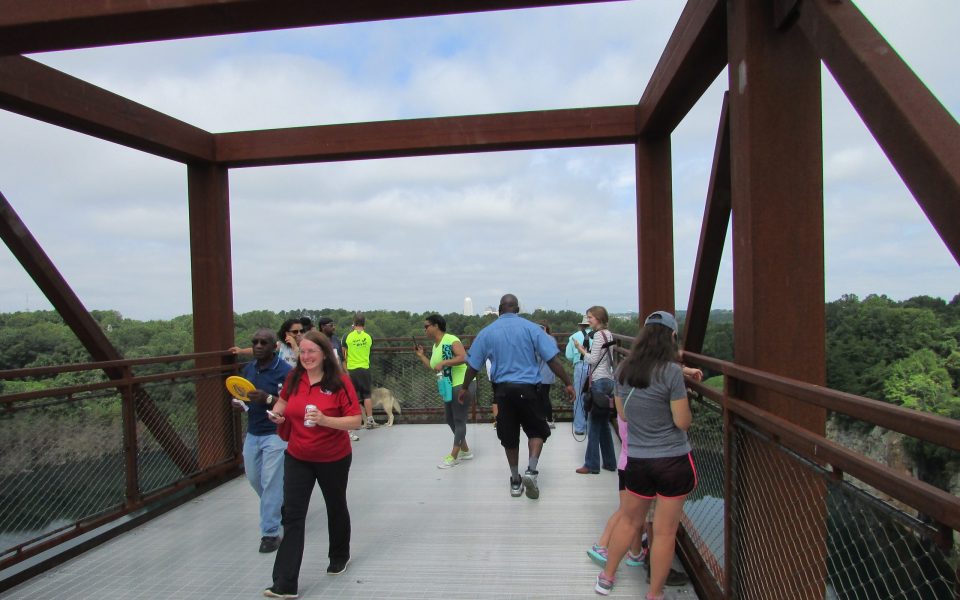Virtually everyone who grew up in southeast Winston-Salem, it seems, has a story about the old Vulcan Materials Quarry, which wound down operations in the mid-1970s and was donated to the city in 1998.
Councilman James Taylor, who represents the Southeast Ward, came there with his dad when he was a youngster for a talk about “the birds and the bees.”
Over the years, the secret has gradually leaked out. During a ribbon-cutting to mark the opening of the new Quarry Park on Tuesday, Councilman Dan Besse admitted to “slipping past an open gate” to explore the site. And Recreation and Parks Director William Royston said on several occasions he would sneak out to the quarry to enjoy a quiet lunch.
After the ribbon-cutting, Tyrone Walker and Frederick Morgan, who grew up in the Morningside neighborhood, reminisced about sneaking in to play in the quarry in the early 1970s while it was still operating. Back then, a road wound into the pit from the west side and spiraled down to the deep end. There was a pond — where the boys pushed in small boulders to make cannonfire-like splashes — and a dilapidated metal shed they had to abandon one night during a downpour when they discovered the roof was half missing.
“They used to run us out of here; they’d say, ‘You’ll step on one of those blasting caps,’” Walker recalled. “That didn’t do nothing but make us want to look for blasting caps. We used to have some good times. We didn’t have a playground; this was our playground.”
They leaned against a fence at the edge of the concrete overlook, gazing at the deep blue pool of water more than 50 feet below, and then beyond the expanse of trees to the downtown skyline protruding in the distance. Walker estimated that the lake might be 200 feet deep, recalling that the dump-trucks and loaders looked like toys from the edge of the pit when the quarry was in operation.
While the children found delight exploring the quarry, their parents complained.
“You can’t imagine how it was when they were blasting,” Morgan said.
“It would shake our house,” Walker added.
In addition to local dignitaries like former state legislator and city alderman Larry Womble, the ribbon-cutting drew a crowd that included children from Camp Hanes Hosiery who swarmed over a collection of bounce castles as well as cyclists and a couple people with yoga mats.
“The stone that was taken out of the quarry over here allowed that town over there to be built,” Councilman John Larson said. “The stone coming out of that quarry would be used as part of the development of that town. And that connection, then, to be able to take that hole and celebrate not only the natural environment of it, but to celebrate the construction of the town is a connection that I love to make.”
The new regional park, financed with $4 million in funds approved by voters in a 2014 bond referendum, adds 200 acres of parkland to the city. It also connects three neighborhoods and provides an additional destination in a developing network of greenways that link Waughtown Street to downtown.
“[The park] is part of what will bring all of our city to you here in the southeast and connect you through the new trail that is now open all the way downtown and beyond around our city, making it easy for folks on foot, walking or bicycling,” Besse said.
Jake Easter, with the advocacy group Beers N Gears, was one of eight people — including a child 6 or 7 years old — who made the 30-minute bike ride from Krankies Coffee in downtown to the ribbon-cutting at Quarry Park.
“It’s a good ride,” he said. “It has challenging parts. We live in Winston-Salem; it’s steep. It was very enjoyable. There’s almost no interaction with cars. It’s all paved. It’s very accessible.”
Join the First Amendment Society, a membership that goes directly to funding TCB‘s newsroom.
We believe that reporting can save the world.
The TCB First Amendment Society recognizes the vital role of a free, unfettered press with a bundling of local experiences designed to build community, and unique engagements with our newsroom that will help you understand, and shape, local journalism’s critical role in uplifting the people in our cities.
All revenue goes directly into the newsroom as reporters’ salaries and freelance commissions.


Leave a Reply